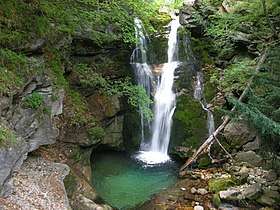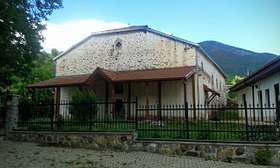Čaška
Čaška (Macedonian: Чашка, Chashka) is a municipality located in Povardarie, west of Veles. The rural municipality has over 7,000 residents spread across 42 villages. The primary area of interest within Čaška Municipality is the historical region of Azot.
Understand
The historical region of Azot, covering the Babuna River valley, lies within the western side of the present Čaška Municipality. Bogomilism, a Christian neo-Gnostic sect, was founded in the First Bulgarian Empire by the priest Bogomil in the 10th century. "Bogomil" means "dear to God", while "Babuni" were followers of Bogomilism. With toponyms retaining these names such as the village of Bogomilia and the Babuna River, it is believed that Bogomilism was very active in Azot.
The region of Azot is traditionally ethnic Macedonian and Orthodox Christian. Čaška Municipality as a whole, however, is more diverse, with Albanians forming 35% of the population and Turks forming 5%. Both of these groups are traditionally Muslim and concentrated in the villages of Dolno Jabolčište, Gorno Jabolčište, Gorno Vranovci, Melnica, and Sogle.
Get in
Get around
See


- 🌍 Memorial House of Petar Pop Arsov (Спомен-куќа на Петар Поп Арсов) (village of Bogomila). This memorial house is dedicated to revolutionary Petar Pop Arsov who was born in the home in 1868. He was one of the founders of "The Committee for Obtaining the Political Rights Given to Macedonia by the Congress of Berlin" which later developed into the Internal Macedonian Revolutionary Organization.
- 🌍 Bogomila Falls (Богомилски водопади) (village of Bogomila). A small waterfall exists north of Bogomila.
- 🌍 Dlabok Dol (Длабок Дол) (village of Dolno Vranovci). About 1.5 km outside of the village of Dolno Vranovci is the geographical centre of the Republic of North Macedonia.
Churches
- 🌍 Church of St Athanasius (Црква „Св. Атанасиј“) (village of Bogomila). In central Bogomila, this church was built in 1837 by notable builder Andon Kitanov. It is a large three-nave church and contains the village cemetery in its courtyard. It is mostly notable for its frescoes, though the church did suffer a fire in 2010.
- 🌍 Church of Sts Peter and Paul (Црква „Св. Петар и Павле“) (village of Papradište). Built in 1875, this is a three-nave church with a semicircular apse. It was built by one of the region's great church builders of the 19th century, Andrej Damjanov, a Papradište native. Its fresco painting was done by two other significant Papradište natives, Dimitar Papradiški and Gjorgji Zografski. The former made 25 of the icons in the iconostasis while the latter made eight.
- 🌍 Church of St Athanasius (Црква „Св. Атанасиј“) (village of Teovo). A late 19th-century church built by Andrej Damjanov and painted by Dimitar Papradiški. It has a newer bell tower in its yard.
- 🌍 Church of the Virgin Mary (Црква „Успение на Пресвета Богородица“) (village of Bistrica). This church built in 1853 is home to significant frescoes and iconostasis. They exist in varying conditions, with some only preserved in fragments.
Archaeological sites
- 🌍 Vrvči (Врчви) (village of Čaška). An archaeological site containing early Christian tombs. It is situated north of Čaška, on the left bank of the Topolka River. There are two separate groups of graves at the site. One group comprises three combined graves in the east-west direction, while the other in the has two graves in the opposite north-south direction. The graves are completely made of stone and mortar in their interior, however they do not have lavish inner workings like the Hereon site. This likely indicates that poorer, middle-class citizens were probably buried here. Findings from the site are kept at the Museum of Macedonia in Skopje
- 🌍 Hereon (Хереон) (village of Čaška). Tombs from the Roman era just north of the village, near newer housing on an asphalt path. It consists of seven coffins inside walls with a diameter of 15 m (49 ft). The tombs most likely date from the 5th century and is believed to contain a local ruler due to its relative monumentality.
Do
Eat
Sleep
Go next
- Veles, the major city of the area